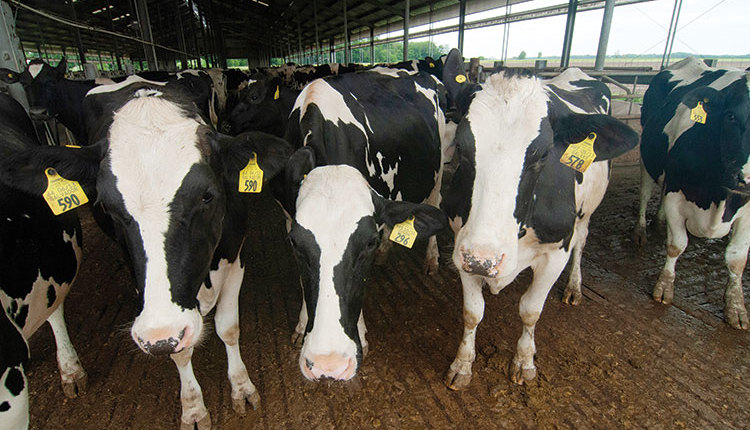The author is professor of animal sciences at Kansas State University, Manhattan.
If you have been A.I. breeding cows for some time, you understand that many factors influence the success of each insemination, not the least of which is cleanliness of the equipment used in the process. Let's look at some cleanliness issues and how you might prevent damage to sperm cells and contamination of straw tips in the process of A.I. breeding.
Common sense practices
How do you keep thawed straws loaded in your A.I. breeding gun at 95° F? Do you slide the French gun inside your clothing? Proper storage of the A.I. gun between semen thawing, straw placement into the breeding gun, applying the breeding sheath, and introducing the A.I. gun into the cow is an important matter. These steps are not only critical to prevent "cold shock" but also to prevent contamination of the tip of the straw.
To prevent "cold shock," many A.I. technicians are using A.I. gun warmers. What is an A.I. gun warmer? It is a heated, battery-operated (rechargeable), temperature-controlled carrying case to carry loaded A.I. guns. It keeps the A.I. guns at the proper temperature and is fully portable to free up your hands. It can be worn on a belt or a shoulder strap. How does it help? It eliminates cooling of thawed semen and provides a convenient and hygienic way to carry multiple guns to reduce potential "cold shock."
Gun warmers can be, however, a source of contaminating the tip of the straw in the loaded A.I. gun if certain precautions are not followed. Most A.I. gun warmers have a removable insert sleeve into which the A.I. guns are placed. This insert sleeve should be cleaned regularly; otherwise it will serve as a pocket source of everything from straw, fecal material, dust, grime, and bacteria! An alternative to very regular cleaning of the insert sleeve is to simply insert a clean palpation sleeve into the gun warmer and replace it every day.
When introducing the A.I. gun into the vagina, it is important to ensure the tip of the breeding gun is kept free of contamination at the entry to the vagina and therein as much as possible. This is always problematic. Whatever the tip of the gun touches is likely to be introduced into the cervix and the uterus. Does this affect fertility? Read on.
Years ago, protective outer plastic sheaths were introduced to protect the tip of the breeding gun. These sheaths slide over the breeding sheath that protects the stainless steel A.I. gun and are not quite as long as the breeding sheath. One end is sealed with a prescored, soft vinyl tip to prevent contamination of tip of the thawed straw in the loaded A.I. gun during passage through the vagina. The other end is flared to facilitate holding the outer plastic protective sheath for perforation of the vinyl tip with the A.I. gun. Once the A.I. gun with the protective sheath has passed through the vagina and is near the cervix, the protective sheath can be pulled back to push the tip of the A.I. gun through the scored vinyl tip perforation.
Two studies reported in 1984 showed that using these protective sheaths had no effect on either nonreturn rates or actual conception rates (Table 1). New research, however, from The Ohio State University has demonstrated how important the protective plastic sheath can be during the A.I. process, resulting in improved fertility and reduced contamination of the A.I. catheter.

The study included 773 lactating dairy cows enrolled in a timed A.I. program. At the time of insemination, cows were assigned randomly to serve as controls or to be inseminated using the protective plastic sheath for all A.I. breedings. One technician performed all services. After A.I. breeding, cultured swab samples were taken from the tip of the A.I. gun to determine the amount of contamination (measured as resulting positive bacterial growth of swab samples). All pregnancies were diagnosed using ultrasound at 39 days post-A.I.
The researchers concluded that the use of the protective plastic sheath: (1) reduced contamination of the A.I. catheter and (2) raised the number of pregnancies in cows in which the protective sheath was used in Table 2 below.

At your next meeting
If you learned something new from the information provided herein, perhaps it should be discussed at your next farm management team meeting. Success is in the little details. I wholeheartedly agree with the following Bruce Fairchild Barton (1886-1967; American writer, advertising executive, and politician) quotation: "Sometimes when I consider what tremendous consequences come from little things, I am tempted to think there are no little things."
Click here to return to the Reproduction E-Sources
1106_407
If you have been A.I. breeding cows for some time, you understand that many factors influence the success of each insemination, not the least of which is cleanliness of the equipment used in the process. Let's look at some cleanliness issues and how you might prevent damage to sperm cells and contamination of straw tips in the process of A.I. breeding.
Common sense practices
- Regularly clean, rinse, and dry A.I. guns. Replace bent ones.
- Thoroughly clean semen-thawing units and replace with clean water.
- Regularly check the temperature of the water in the thawing unit (should be 95° F).
- Warm A.I. guns before loading thawed straws to prevent "cold shock" of sperm (cooling of sperm significantly below the thaw temperature of 95° F).
- Store all A.I. supplies and semen tank in a clean, dry place free of dust and varmints.
How do you keep thawed straws loaded in your A.I. breeding gun at 95° F? Do you slide the French gun inside your clothing? Proper storage of the A.I. gun between semen thawing, straw placement into the breeding gun, applying the breeding sheath, and introducing the A.I. gun into the cow is an important matter. These steps are not only critical to prevent "cold shock" but also to prevent contamination of the tip of the straw.
To prevent "cold shock," many A.I. technicians are using A.I. gun warmers. What is an A.I. gun warmer? It is a heated, battery-operated (rechargeable), temperature-controlled carrying case to carry loaded A.I. guns. It keeps the A.I. guns at the proper temperature and is fully portable to free up your hands. It can be worn on a belt or a shoulder strap. How does it help? It eliminates cooling of thawed semen and provides a convenient and hygienic way to carry multiple guns to reduce potential "cold shock."
Gun warmers can be, however, a source of contaminating the tip of the straw in the loaded A.I. gun if certain precautions are not followed. Most A.I. gun warmers have a removable insert sleeve into which the A.I. guns are placed. This insert sleeve should be cleaned regularly; otherwise it will serve as a pocket source of everything from straw, fecal material, dust, grime, and bacteria! An alternative to very regular cleaning of the insert sleeve is to simply insert a clean palpation sleeve into the gun warmer and replace it every day.
When introducing the A.I. gun into the vagina, it is important to ensure the tip of the breeding gun is kept free of contamination at the entry to the vagina and therein as much as possible. This is always problematic. Whatever the tip of the gun touches is likely to be introduced into the cervix and the uterus. Does this affect fertility? Read on.
Years ago, protective outer plastic sheaths were introduced to protect the tip of the breeding gun. These sheaths slide over the breeding sheath that protects the stainless steel A.I. gun and are not quite as long as the breeding sheath. One end is sealed with a prescored, soft vinyl tip to prevent contamination of tip of the thawed straw in the loaded A.I. gun during passage through the vagina. The other end is flared to facilitate holding the outer plastic protective sheath for perforation of the vinyl tip with the A.I. gun. Once the A.I. gun with the protective sheath has passed through the vagina and is near the cervix, the protective sheath can be pulled back to push the tip of the A.I. gun through the scored vinyl tip perforation.
Two studies reported in 1984 showed that using these protective sheaths had no effect on either nonreturn rates or actual conception rates (Table 1). New research, however, from The Ohio State University has demonstrated how important the protective plastic sheath can be during the A.I. process, resulting in improved fertility and reduced contamination of the A.I. catheter.

The study included 773 lactating dairy cows enrolled in a timed A.I. program. At the time of insemination, cows were assigned randomly to serve as controls or to be inseminated using the protective plastic sheath for all A.I. breedings. One technician performed all services. After A.I. breeding, cultured swab samples were taken from the tip of the A.I. gun to determine the amount of contamination (measured as resulting positive bacterial growth of swab samples). All pregnancies were diagnosed using ultrasound at 39 days post-A.I.
The researchers concluded that the use of the protective plastic sheath: (1) reduced contamination of the A.I. catheter and (2) raised the number of pregnancies in cows in which the protective sheath was used in Table 2 below.

At your next meeting
If you learned something new from the information provided herein, perhaps it should be discussed at your next farm management team meeting. Success is in the little details. I wholeheartedly agree with the following Bruce Fairchild Barton (1886-1967; American writer, advertising executive, and politician) quotation: "Sometimes when I consider what tremendous consequences come from little things, I am tempted to think there are no little things."
1106_407










